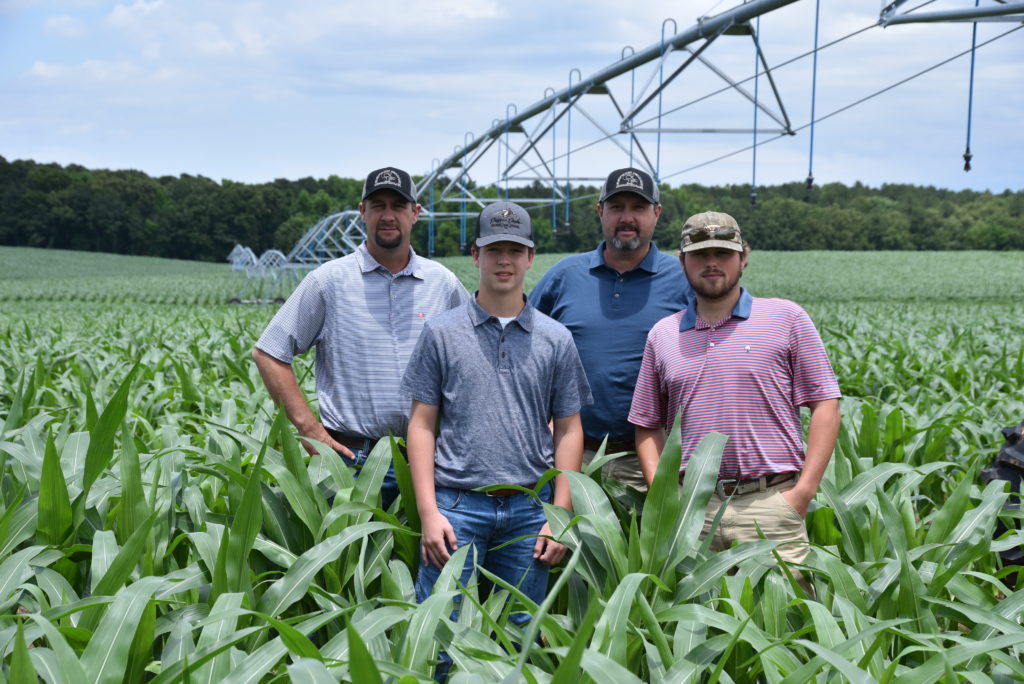Water Wise: Irrigation Initiative Eliminates Guesswork

By Jeff Helms
Torrential rains gave way to blue skies just in time for the Darnell brothers of Lawrence County to show how the Alabama Irrigation Initiative takes some guesswork out of farming.
Steel skeletons, which crawl across 12% of their 6,000-acre farm, sat silent. But Heath Darnell, 45, said it’s reassuring to know the irrigation pivots can deliver water to corn, cotton and soybeans when needed.
“We can do everything right, but if it doesn’t rain for 10 days, we can be hurting,” he said. “We can go from being too wet to get anything done to needing a rain badly.”
The initiative helps farmers like the Darnells mitigate risk by providing cost-share assistance for irrigation equipment. Funding was secured by U.S. Sen. Richard Shelby, R-Ala., and Rep. Robert Aderholt, R-Haleyville, through the U.S. Department of Agriculture Natural Resources Conservation Service (NRCS).
Kathy Gotcher is a senior conservationist with the Alabama Soil and Water Conservation Committee (ASWCC), which administers the program. The initiative pays 50% toward new irrigation equipment, up to $250,000. One of the most impactful investments, however, is the $10,000 farmers receive for an irrigation water management system. This includes a soil moisture probe, flow meter, weather station and three-year subscription to monitoring software.
“Vendors have told me they have producers who’ve installed the soil moisture probes under our program who are now installing them on other pivots,” Gotcher said.
Standing in chest-high corn, Heath demonstrated the software. Using a smartphone app, he can access information provided by the solar-powered monitoring station. At ground level, a PVC pipe conceals the data-gathering probe. Irrigation vendors install equipment each spring and remove it before harvest. The technology is another way to increase efficiency while conserving resources.
“A farmer, by nature, is going to overdo it,” Heath said. “In the past, we watered an inch a week whether the crop needed it or not. With these moisture probes, I’m seeing that sometimes I don’t need that inch a week. Maybe it’s an inch over 10 days with two or three passes.
“If I’m putting on too much water, I’m wasting money and losing topsoil. You can save a tremendous amount of money by not overwatering. These probes pay for themselves,” he added.
The irrigation management software is tied to planting date. Graphs show how deep the plants’ roots should be and how much water is needed at each stage of growth.
The Darnell brothers said some of their systems take 40 hours to cover a field with an inch of water. Consequently, plants on the far side of the pivot could suffer almost two days before getting relief. Applying less water allows the pivot to move faster.
“A field of growing corn uses so much more water than I realized before we had the monitoring stations,” said Jared, 50. “Instead of waiting for the crop to look stressed, Heath can watch the graph and know when to irrigate, even if it seems like it rained just a few days ago.”
The Alabama Irrigation Initiative has invested $1.9 million on 19 farms in the Middle Tennessee River Watershed, which includes parts of Cullman, Jackson, Lauderdale, Lawrence, Limestone, Madison, Marshall and Morgan counties. Expansion is underway in the Choctawhatchee and Pea Rivers Watershed, including parts of Barbour, Bullock, Coffee, Covington, Dale, Geneva, Henry, Houston and Pike counties. Scientists are also working to bring the initiative to farms in the Middle Alabama River Watershed.
Alabama has about 160,000 irrigated acres, compared to over 1 million in each neighboring state. Jared said increasing on-farm irrigation benefits the entire state.
“Alabama is a corn-deficient state,” he said. “This will help us grow more of our own corn to feed the poultry industry.”
Good relationships are key to the initiative’s success. ASWCC, NRCS, local soil and water conservation districts, irrigation vendors and researchers at Auburn University and University of Alabama Huntsville helped make the program a reality.
The Darnells said the initiative made irrigation affordable, especially for smaller fields.
“Before the program, it was very hard to put in an extensive irrigation program because you were investing a lot of money,” Heath said. “You’re looking at a 10- to 15-year return on your investment. You need to have a good relationship with your landlord, and they should be able to handle the expense of everything underground that stays with the land.”
Although the brothers rent most of their land, Jared Darnell said they are blessed with good landowners and neighbors.
“We’ve been renting land from the same people in a lot of instances for over 30 years,” he said. “Our neighbors are really good farmers, and a lot of what we do is from watching them.”
The Darnells operate as Clifton Farms, a shared family name. Since 1993, the brothers have more than tripled acreage. They utilize a three-year crop rotation, minimum tillage, cover crops, terracing, grass waterways, soil sampling and precision agriculture.
Those techniques and management philosophy factored into their selection for the initiative, Gotcher said.
Riley Darnell, who farms alongside his father, Jared, and uncle Heath, said the investments make the farm sustainable for his generation.
“Everything we’re doing is only building for my future,” he said. “When I first started, we didn’t have any pivots; we had hard hose reels. You’d work yourself to death and not feel like you were doing any good. It’s come a long way. In farming, we know a lot of stuff may happen, but the crop is not going to dry up. That’s a game changer.”
